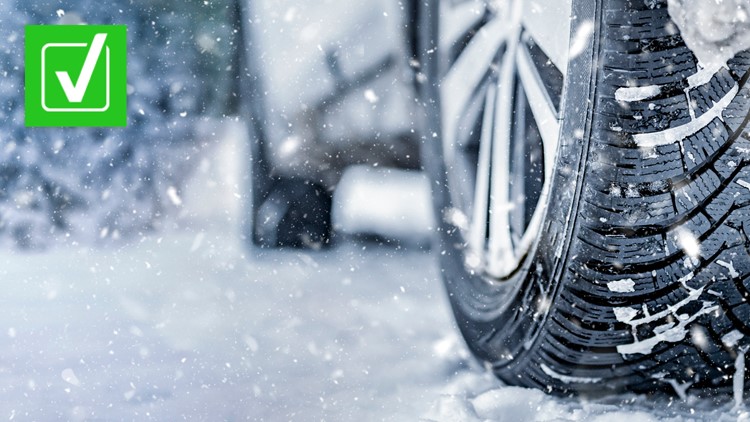As winter nears, many people across the country are waking up to freezing temperatures. And some of these people are finding their cars’ tires look deflated or the tire pressure warning has lit up on their dashboard just as they’re ready to leave for work.
Over the past month, and particularly the past week, Google searches about how cold affects tire pressures have been rising.
THE QUESTION
Does tire pressure drop as the weather cools?
THE SOURCES
THE ANSWER
Yes, tires lose pressure as the weather cools.
WHAT WE FOUND
The air pressure in a tire can rise or fall 1-2 psi, or pounds per square inch, for every 10 degrees Fahrenheit change in temperature, according to tire manufacturers Goodyear and Firestone. Tire pressure drops when the temperature gets colder, and rises when the temperature gets warmer.
So if you inflate your tires in the middle of the day when it’s 75 degrees outside and the temperature drops to 25 degrees a few days later, your tire pressure could drop by 5 to 10 psi.
The recommended tire pressure for passenger cars usually is between 30-35 psi, or pounds per square inch, Firestone says.
Air pressure depends on the temperature of the air and the density of the air molecules, the University Corporation for Atmospheric Research (UCAR) Center for Science Education says. So when the air in your tire heats up, it expands and causes the tire pressure to rise. Conversely, the air in your tire contracts and its pressure drops when the air is cooler, Discount Tire, a tire retailer, says.
Underinflated tires can cause reduced traction, handling and durability, Goodyear says. Firestone adds that underinflated tires can also lower your gas mileage and increase your braking time.
But you don’t want overinflated tires, either. Erie Insurance warns that overinflated tires can also make your car handle poorly, and could even lead to a blowout.
Discount Tire says it’s critically important to check your tire’s air pressure regularly, especially during the colder months. When you do check your tires, Discount Tire says it should only be after your car has had a chance to sit for a few hours or before you start driving. That’s because your tires will heat up when you drive, and your car’s recommended tire pressure is based on their pressure when cool.
Most newer vehicles are equipped with a Tire Pressure Monitoring System (TPMS), which is a warning light on your dashboard that alerts you if it senses a low tire.
Your vehicle’s TPMS is designed to activate once your tire pressure reaches a certain threshold, typically about 25% below the recommended pressure, Erie Insurance says. When that alert comes on, you should add air to your tires as soon as possible.
You can find your car’s recommended tire pressure in your vehicle’s owner manual or on a sticker attached to your car’s door jamb, glove box or fuel hatch, Firestone says. The recommended tire pressure is the tire pressure you should have before you begin driving and heating your tires up.
You can check your tire pressure with gauges sold by retailers for as little as a few dollars. Many gas stations have air pumps for tires, and sometimes offer them for free.
This story is also available in Spanish / Lee este artículo también en español: Sí, la presión de tus llantas disminuye cuando hace frío



